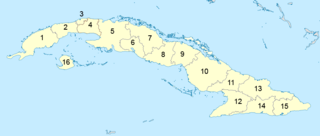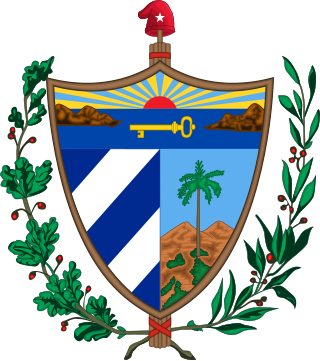Related Research Articles
Transportation in Cuba is the system of railways, roads, airports, waterways, ports and harbours in Cuba:

Administratively, Cuba is divided into 15 provinces and one special municipality. The current structure has been in place since August 2010, when the then-La Habana Province was divided into Artemisa Province and Mayabeque Province.

The Democratic Solidarity Party was a political liberal party in Cuba. Although changes to the Cuban constitution in 1992 decriminalized the right to form political parties other than the Communist Party of Cuba, these parties are not permitted to campaign or engage in any public political activities on the island. The Democratic Solidarity party described itself as "an organization from within Cuba promoting democracy and the respect for human rights by the peaceful route." The last President of the party was Fernando Sánchez López. The party was a full member of Liberal International.

The Cuban National Series is a domestic baseball competition in Cuba. Formed after the dissolution of the Cuban League in the wake of the Cuban Revolution, the National Series is a part of the Cuban baseball league system. Between 1961 and 2021, it was the top-level winter league in Cuba; it now operates as a summer league, with the top six National Series teams qualifying for the Cuban Elite League.
The Campeonato Nacional de Liga de Fútbol de Cuba is the top football division in Cuba. Currently, it is contested by 16 clubs and is divided into two tournaments – "Apertura" and "Clausura", with the last being the championship tournament. The champion of each tournament, decided via a playoff match ("Final"), are qualified to Supercopa Nacional de Fútbol de Cuba. The league currently has a fixed membership with each club being a representative of a Cuban province, which makes it one of the football leagues that does not have a promotion and relegation process.

The provinces of Cuba are divided into 168 municipalities. They were defined by Cuban Law Number 1304 of July 3, 1976 and reformed in 2010 with the abrogation of the municipality of Varadero and the creation of two new provinces: Artemisa and Mayabeque in place of former La Habana Province.

[[Image:|thumb|]] Cienfuegos Province Botanical Garden, officially, Jardín Botánico de Cienfuegos, also known as Jardín Botánico Soledad, is located 14 kilometres (8.7 mi) from Cienfuegos city centre.

Manicaragua is a municipality and mountain town in the Villa Clara Province of Cuba. It is located in the Escambray Mountains at the southern part of Villa Clara, bordering the provinces of Cienfuegos to the west and Sancti Spíritus to the east.
Juan Andrés Rodríguez better known by his artistic name El Monje. He was a Cuban artist specializing in painting and drawing.

The following outline is provided as an overview of and topical guide to Cuba:
Punto guajiro or punto cubano – or simply punto – is a sung genre of Cuban music, a poetic art with music. It became popular in the western and central regions of Cuba in the 17th century, and consolidated as a genre in the 18th century. It has Andalusian and Canary Islands origins, and it integrated African elements in Cuba.
The Liga Superior de Baloncesto (LSB) (English: Superior Basketball League) is the highest level men's professional basketball league in Cuba. The LSB has been active for twenty-eight years, interrupted only three times, once in 2011, 2014, and in 2020.

The road network of Cuba consists of 60,858 km (37,815 mi) of roads, of which over 29,850 km (18,550 mi) are paved and 31,038 km (19,286 mi) are unpaved. The Caribbean country counts also 654 km (406 mi) of motorways (autopistas).

The Autopista A1, also known as Autopista Nacional, is a Cuban motorway, partly built, that will link Havana to Guantánamo. It is a toll-free road and its total length will be of about 900 km (560 mi). Along with the Autopista A4, linking Havana to Pinar del Río, it is classified as part of the whole Autopista Nacional route, spanning the length of the island; as the Carretera Central highway.

The La Reforma Campaign was a campaign of the Cuban War of Independence which was waged for 16 months with the Cuban forces under the command of Máximo Gómez against the Spanish forces under the command of Valeriano Weyler. Despite the Spanish outnumbering the Cuban forces by 40,000 to 600, Gómez's guerrilla warfare tactics as well as the weather caused over 40 Spanish soldiers to die each day throughout the campaign. His approach was to divide his forces into tiny guerrilla groups and fight alone with his General Staff while continuously moving.
References
- ↑ Scott, Rebecca J. (2007). "A Cuban Connection: Edwin F. Atkins, Charles Francis Adams, Jr., and the Former Slaves of Soledad Plantation". Massachusetts Historical Review. 9: 7–34.
- ↑ "Soroa Orchid Garden". Botanic Gardens Conservation International. Retrieved November 8, 2024.